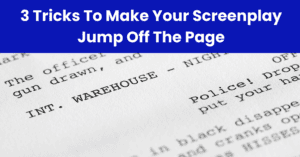As Mr Myagui says to Daniel in The Karate Kid
“There is no such thing as bad student, only bad teacher!”
Obviously he never taught a student that didn’t really want to be there but he does have a point.
Bad lessons have a negative effect on students, they can undermine an entire screenplay and result in you approaching an aspect of your writing the wrong way.
This can be extremely fatal to your projects and detrimental to your craft as a screenwriter.
And bad advice can stay with you a long time.
The following is a list of the bad advice that I have either witnessed, heard second hand or are commonly taught at film schools, lectures and screenwriting books.
It is important to remember advice can be a complex area to navigate
because advice is often context based and can be helpful in the correct circumstances.
Generally speaking advice is best viewed as a tool not a rule.
I have supplied contexts and some remedies to these bad lessons
to help you when you encounter these pieces of advice.
So let’s have a look at 9 of the worst screenwriting lessons.
- “Write what you know”
- “Write a vomit draft”
- “Break the rules”
- “Follow a prescribed structure based on page numbers”
- “Get someone to read your initial work”
- “Wait for inspiration”
- Calling an outline a treatment
- “Show don’t tell”
- “Don’t worry about the budget”
1. “Write what you know”
This advice has been uttered in countless classes, books and seminars and is best not to take literally.
However there is a reason behind it and I’ll give you a solution.
First let’s look at why ‘write what you know’ is bad advice.
Most of our lives are dull and would make for boring screenplays.
Even if you think you live an interesting life or even feel that it is exciting the truth is your relationships, work and social life for the most part are standard, even mundane and don’t interest people for more than a few minutes.
But lets say writers take this advice and write about their life experience, then the majority of screenplays would be about an aspiring screenwriter who struggles to balance their life between writing, working and their family.
I can see the movie poster right now!
The other variation of this is the writer’s screenplay is about an area they know well, which is usually their work like being a doctor.
Their screenplay becomes an accurate depiction of what it’s like to be a doctor,
Doctors will marvel at how accurate it is, even the terminology is correct.
Knowledge and understanding are important but not everything and accuracy doesn’t make for engaging story telling.
So this accurate and realistic script has no actual story and produces will pass on it.
Even a cursory glance at screenplays that have been written shows most writers don’t write what they know.
How many writers of serial killer stories have murdered people?
What experience lead Roald Dahl to write Charlie and The Chocolate Factory.
This is why ‘write what you know’ is flawed thinking, it dismisses the fundamental tools a writer has of
imagination
creativity
observation
and research.
True, many writers will have a natural inclination towards certain topics and are better equipped to tackle specific content but if you are interested in an area you can become an authority on a subject matter.
One of the things I love about writing films is that each screenplay is akin to undertaking an educational course on a topic.
Over the years for projects I have learned
the psychological components of Obsessive Compulsive Hoarding
procedures for ethical hearings
advanced crime investigation techniques
and superstitions of Korean culture.
Research is integral to any writing process and is a skill that can be learned.
I detail how to research like a pro in my online course One Step A Day Screenplay.
So don’t
‘write what you know’,
when an idea excites you, grabs your interest or sparks your creativity
‘get to know it’
then write an engaging and exciting screenplay on that subject.
2. “Write a vomit draft”
I’m not referring to your first pass at your screenplay after you’ve done your preparation.
I’m referring to the ill advised technique of writing a ‘vomit draft’.
The delightful term vomit draft refers to metaphorically throwing up on the page by writing everything on your mind into a draft, usually in a short intensive period.
The vomit draft gives you a false sense of achievement, it shows you can write pages, you have written a 103 page draft of a feature film but it’s glorified doodling.
Vomit drafts sprawl, lack coherence and focus.
Most of the dialogue is unspeakable even for the most talented actors and there is often no structural build in the story.
I’ve always found this advice bad because it is mostly wasted writing time, little of it will be usable and it commits you to the flaws in the story.
Once you’ve written your vomit draft you’ll fall in love with some of your dialogue and scenes then cling to them for months, even years, when perhaps they are not needed or are downright poor writing.
Imagine building a vomit house.
“I have so many ideas i’ll build them all, without consideration or direction”.
Just free flowing with whatever pops into my mind.
When you come to rebuild that house you realise there are a few problems.
In fact a lot.
It has too many rooms.
The colour of the walls and the carpet clash.
It has 3 levels and you only need 2.
It needs more windows.
The bathroom is at the opposite end of the house to the laundry.
In fact you don’t really like it.
Most of it is unusable but you have put time and effort into it so maybe you can keep it as it is and make a few changes then tell people why it’s a really good design
Or
You can go back and rebuild it from scratch, which you could have done before you did the vomit build.
Either way time and energy have been wasted.
However there are always exceptions to the rule.
I find at certain points a vomit scene can be really helpful.
If you are stuck on what direction a scene should go and you have no idea how it should play but you know it needs to be in your screenplay, it doesn’t hurt to spend a little bit of time writing a few possibilities exploring and brainstorming ways it could play out, dialogue exchanges, picking different perspectives to tell the scene from or physical actions within the scene.
This process gives you freedom to explore ideas, possibilities and directions.
It may give you the necessary insight into what the scene really is about or help you realise what the scene definitely isn’t about.
In this context it can be a valuable process occasionally for finding your way into a scene but it is too haphazard to write every scene this way and certainly a terrible approach to an entire draft.
The only thing worse than writing a vomit draft, is giving the vomit draft to someone to read.
3. “Break the rules”
This appeals to the rebellious and creative streak that writers have.
It seems like a good idea, even romantic to a writer but it is fraught with danger and often comes off as a creative tantrum or showing off that you are smarter than the audience.
The advice comes from the misunderstanding of the difference between rules and formulas.
Rules are principles, methods and conventions that have been tried and tested over a long period of time and have become integral to storytelling.
Formulas are a prescribed guideline that says you must do something this way.
To break a rule for the sake of it is almost a guarantee to disappoint your audience.
Let’s have a look at a story rule.
Fundamental to any story is
‘The audience needs to see the protagonist experience the climax of the story’.
It doesn’t have to be an up ending, it can be a down ending or even have some ambiguity but we need to see the protagonist experience the climax.
To break that rule would be to not show the protagonist experience the climax.
That would be anti climatic, disappointing and the audience will feel cheated.
I love the end of Silence Of The Lambs.
It uses two types of endings, the climax of the main story is the incredible sequence that begins with Clarice knocking on the door of a house with a routine inquiry and she realises she is now in the lair of Buffalo Bill, the serial killer she is in fact chasing.
We are in there with her and witness how she saves herself and the next victim Buffalo Bill has imprisoned from this terrifying situation.
It is one of the all time great moments in cinema history.
Now let’s rewrite that and break the rule.
Clarice approaches the house knocks on the door
then we cut to the FBI headquarters, her colleagues are worried as they haven’t heard from her.
Then she comes striding in carrying the imprisoned woman and she describes how she was trapped in his lair and terrified but shot him dead.
Take your pick on which ending you want to watch.
The one that follows the rule or the one that breaks it.
However Silence Of The Lambs is by no means a formula film.
The subplot of the screenplay, the Hannibal Lecter story, has an ambiguous ending.
Hannibal, a cannibal sociopath, has escaped prison and is free to kill the prison warden who tormented him.
The audience doesn’t see how this story ends, it is left open.
However it doesn’t matter as we have the satisfaction of seeing the main plot climax.
It also helps that the last scene ends on the classic and sardonic line from Hannibal
“I’m having an old friend for dinner”.
Here’s another rule of screenwriting
The audience and protagonist must see the inciting incident.
This is the event that throws the main characters world out of balance and ultimately leads them to set a goal they must achieve by the end of the story.
For example,
Seven
The Inciting incident is – two detectives – Brad Pitt and Morgan Freeman – stand over the body of a murdered obese man.
Their goal becomes
‘to find the killer and deliver justice’.
This event can’t happen off screen.
What if you break this rule and the event happens off screen, we are told about it through a conversation.
What is the effect?
Well the audience doesn’t feel the importance of the event so they will be disoriented and most likely suspect, because it wasn’t on screen, it’s still part of the set up and they’ll be waiting for the actual inciting incident to happen.
By the time they realise the off screen event that was discussed between Freeman and Pitt was the inciting incident they are disconnected, confused and are now thinking about the flaws in the mechanics of the story.
I am not suggesting you be a slave to rules far from it.
The key to breaking the rules is understanding them and if you are going to break them then it must be with a purpose and what is put in it’s place must be better.
Seven is a great example of breaking the rules and subverting expectations.
In a detective story the detective investigates until they unravel the mystery and eventually work out who and how the crime was committed.
At the climax the killer is caught and brought to justice – The Silence Of The Lambs
or the detective unravels the mystery but it is too late or they were wrong about something and they don’t deliver justice – Chinatown.
However, Seven breaks this rule and convention.
As the story nears the climax the detectives don’t catch the killer.
The killer gives himself up.
It’s a thrilling moment
that leaves the audience wondering
‘what the hell is going on’.
but the writer has a brilliant reason for doing this.
The killer giving himself up is part of his master plan.
When the detectives and audience realise what that plan is we are simultaneously shocked and in awe of its brilliance.
The writer broke the rule but they did it brilliantly and put something new and even better in its place.
So be flexible, keep an open mind and definitely don’t just slavishly follow every rule
But
Understand and respect the principles of story telling that have been established over centuries
And
If you break the rules it better be for a damn good reason.
4. “Follow a prescribed structure based on page numbers”
This comes from the belief that there is ‘a perfect formula for structuring screenplays’ .
I don’t want to get heavily into the structure vs anti structure debate as there are structure conventions you need to adhere to but there is lots of advice to the effect of
‘this event must happen on this page’.
Now there is some value in this approach as it’s a useful guide but the idea that a specific event must happen on page 5 then another specific event on page 12 and another on page 65 just doesn’t hold.
Look at the films screening on any given day at the cinema, they all run at different lengths and certainly not every event happens in unison.
Some films take longer to get going, action films often start with a long action sequence which may not even be connected to the main plot.
Other films have the inciting incident in the first few pages.
Night Of Living Dead – Barbra and her brother are attacked by a zombie in the cemetery at 6 minutes
Casablanca – Ilsa steps into Ricks Bar and his life at 33 minutes
Star Wars – Luke sees R2D2 project Princess Leah’s distress message at 22 minutes
Jaws – Chief Brody stands over the remains of the female swimmer at 8 minutes.
There is a counter argument that events appear on pages based on the ratio and script length.
That means in a shorter script the events happen earlier.
But Jaws and Night Of The Living Dead run for 90 and 120 minutes respectively
and their inciting incidents are at 8 and 6 minutes respectively.
Also there is variation in the use of plot points.
Not all films have true midpoints – Misery and Stand By Me.
Some films only have two acts – Full Metal Jacket and Mad Max Fury Road.
Some films don’t have subplots – Before Sunrise.
It should also be noted this approach is very helpful for a certain type of modern US studio film.
If every film around the world followed it films would all formulaic, feel the same and watching them would become a generic experience.
Again there is value in the page count structure as a general guide.
Having an inciting incident in the first 10 pages is a great way to grab your reader and plot points at regular intervals is important for maintaining pace and keeping your audiences interested.
So use it as a guide but know that your screenplay doesn’t have a fatal flaw if the inciting incident doesn’t happen on a prescribed page.
5. “Get someone to read your initial work”
This piece of advice is often given in the context of
“to ensure that you are on the right path”
Or
“you’re onto something”
with your story.
So you sketch your idea out or write a rough draft then give it too someone to read.
This is a bad idea for 2 reasons.
Number 1 – first impressions last.
You only get one first read from a person so use it wisely.
The second reason:
you can kill an idea by getting external input too early.
You need to do the initial work and sort out the story components.
In an early draft you are still discovering and perfecting your story.
If you get input too early you may get advice that puts you off the idea
or change the focus of the story on the whim or value judgement of the reader.
Essentially you are writing to feedback way to early in the process.
The other common outcome is you talk it to death
as in truth, you are still trying to nut out aspects of the story and you are using someone as a sounding board.
This often ends in never getting around to writing it.
Having said that not every idea you have is worthy of a screenplay and the question becomes, is it wise to invest the time and energy into writing this particular screenplay?
It’s a fair question to ask because it is a lot of work and emotional energy.
You need to decide that one yourself rather than asking someone else.
When is a good time to get feedback?
From either a developed draft or a 3-5 page detailed story outline.
From both these documents an experienced reader will be able to determine where the strengths, weaknesses and potential problems in your story lie.
In Screenplay Method I detail how to writer a killer story outline that producers want to read.
6. “Wait for inspiration”.
The problem with this one is you could be waiting for a long time.
There is one thing all writers are gifted at procrastination!
This myth of waiting for inspiration is the perfect procrastination method as you can delude yourself that you will work the minute you have a spark of inspiration and when that happens you hit the desk and start writing.
Problem is that moment might not happen for a long time.
If ever.
Creativity is about discipline and hard work.
It comes from sitting in a seat with a pen or pencil in your hand or laptop at your fingertips and writing because
thinkers think
talkers talk
writers write
Creativity is a muscle that needs to be developed practiced and flexed.
All the successful screenwriters, novelists and musicians have schedules that they stick too.
They know they need to consistently and regularly dedicate time to their craft even when they aren’t feeling inspired or motivated.
If you force yourself to be creative there is one of two outcomes.
The first is you are creating content.
If you sit down and brainstorm a concept for a film you might like the idea.
Great.
By forcing yourself to be creative you came up with the idea for your next screenplay.
If you don’t like the idea and choose not to pursue it
you are now a step closer to the next idea you are going to write.
The side effect of this process is you gain confidence through practice.
I’ll give you two options to try over the next two weeks
see which one you prefer.
The first you are going to wait for inspiration.
No pressure, if inspiration hits, start writing, if not don’t stress, it will happen…at some point.
If you get to the end of the fortnight and nothing inspired you don’t fear, there is always next week and inspiration might hit you then…hopefully.
The other option for the 2 weeks is going to require 15 minutes.
Each day you are going force yourself to come up with an idea for a feature film and write the basic premise in 2 – 4 sentences.
If you write longer that is fine, if it doesn’t come that easily or your head hurts from thinking that is perfectly normal but each day you have to write a few sentences detailing a new idea for a feature film.
As a reward for your effort you can take the weekend off and start again on Monday but feel free to spend 15 minutes on Saturday and Sunday coming up with another idea.
Do the same for week 2 then take the weekend off.
The Monday morning assess the results of both options.
The first option.
The worst case scenario is a blank piece of paper staring back at you.
You have zero.
You are in exactly the same place as two weeks ago.
Best case scenario is inspiration struck and you have an idea you want to pursue.
You got lucky.
What if you started developing this idea but after a few weeks you realise it wont work as a feature film so you stop writing it and are back at square one waiting for inspiration.
Second option
You have spent 2.5 – 3 hours out of 12 – 14 days forcing creativity and what do you have in front of you?
10 – 14 ideas that could be your next feature film screenplay.
That’s a pretty good return in my opinion.
In a month you can have 25 – 30 ideas to pick from!
Suddenly you feel like you have boundless creativity and can come up with film ideas at will.
You now also have the advantage of picking the best ideas you’ve created
and the luxury to write the one that excites you the most.
If, like the first option in a few weeks you realise it won’t work as a feature you can return to your list of 12 – 20 ideas and pick another to explore.
Don’t wait for inspiration.
Motivate and inspire yourself and you’ll create more than you can imagine.
7. Calling an outline a treatment
“Would you like to read my 3 page treatment”?
Or in a writing course you are instructed to
“write a 5 page treatment”.
You hear words to this effect all the time but this is wrong.
This is widely taught piece of misinformation which comes from a widespread misunderstanding of what a treatment is.
There is no such thing as a 3 or 5 page treatment.
What people are referring to is an outline.
Outline and treatment are not interchangeable terms.
They are different documents and serve very different functions in the development of a screenplay and it’s subsequent marketing.
It’s really important to understand the difference and the purpose of each document.
An outline is an extended synopsis that summarises the story of your screenplay.
It’s a piece of prose detailing the story events and plot points, usually 3 – 5 pages long and includes the beginning, middle and end.
It can be read quickly and by the end the reader should understand the whole story.
A treatment details or treats the individual scenes that will be in your script.
It is a much longer and more detailed document containing a scene by scene description of the events.
It contains the thoughts of each character in the scene
and their perspective of what is happening.
But they rarely contain any dialogue a few key lines at the most.
Some treatments are 20 pages long, others are 50 plus pages.
They used to be more than 200 pages back in the 1930’s.
Sounds excessive but have a look at how many great screenplays were written in that era.
Another fundamental difference between the two documents is who reads them.
An outline can be read by others who aren’t involved in the project, they are great to send to producers to interest them in your screenplay and professionals can read it and give you feedback and identify if aspects of your story aren’t working.
Whereas a proper treatment is rarely read externally.
It can be a heavy and cumbersome document that isn’t designed to be read from start to finish.
Refer to my other post “The difference between the an outline and treatment how to write each”.
8. “Show don’t tell”
It’s almost impossible to write a screenplay that doesn’t tell some information.
If there isn’t any telling then a screenplay will have to flashback and dramatise everything that’s referred to.
Telling can be in incredibly efficient way to get across information about characters, context and events.
Most films have a moment where a character explains to another character something that the protagonist has done in the past which gives us an insight to who they are.
“He’s the hardest working doctor, once he worked 90 hours…without a break”.
“She’s the kind of detective that politics can’t touch”.
If you never tell something then every monologue in film history would have to go.
Possible the most terrifying scene in Jaws is the incredible monologue where Quint tells the story of how he was on the USS Indianapolis that was sunk in WW2.
Hundreds of men clung to wreckage in the shark infested waters but over several days they were picked off one by one and eaten.
A brilliant scene which tells rather than shows.
Show don’t tell is a really helpful and important principle but sometimes a 3 second line of dialogue as opposed to a 2 minute scene might be exactly what your screenplay needs.
There is a big but.
If we only hear characters talk about the events that have happened it defeats the purpose of watching a film and will feel very unsatisfying.
So what to tell and show?
A really good way to look at it is to show all the key events that happen to the protagonist in the main plot.
If your story is about a man who is unfairly sacked from their job and is going to fight for justice and have their name cleared you can’t have him tell his best friend he got sacked from their job unfairly and is going to fight to save his reputation.
The audience needs to see him being sacked and the unfair justification.
He can then tell his friend he is going to fight it and we need to see how he fights it.
Likewise with the climax of the story he can’t be sitting in a bar and tell his best friend how eloquent he was in court arguing and proving his innocence.
We need to see and experience that eloquent defence of his reputation in court.
Subplots don’t need to have their climaxes happen on screen and often the outcome of a subplot is articulated at the end of the film rather than seeing it.
Use your judgment on when you need to show and when you need to tell.
9. “Don’t worry about the budget”
I’ve heard some people say
“What your screenplay will cost to make is the producers concern you just worry about writing it”.
When a producer is reading a script to potentially make they have 3 questions in their mind.
Does the story interest me enough to invest years of work making it?
Is there a market for the film?
And
What will it cost to make?
Not all producers can make all films.
If you write a $100million or even a $20million screenplay most producers don’t have the experience to produce a film that big or the contacts to raise such a huge amount of cash.
If your screenplay is going to cost $100million you have one option for it getting made and that is by one of the major studios in Hollywood.
To secure finance they will require at least a star, probably 2 or 3 and an A List director at the helm.
Without those elements the film will never happen, it’s too much of a financial risk.
If you write an expensive spec script, a studio exec reads it
and desperately wants to purchase the screenplay and make it, money is no object, they’ll find and spend $150million.
However spec scripts for blockbuster films are rarely bought and financed by studios these days.
Mostly they commission and develop existing properties like books, comics and franchises then hire established writers to write them.
So if your first screenplay as an unestablished writer costs $100million it is unlikely it will ever be optioned and made by a studio.
The good news in the US and across the rest of the world is that the majority of films aren’t made by the big studios.
Most producers and production companies buy screenplays that can be made for a low to medium budget of $250,000 – $12 million range and most well under $10 million.
So the smaller your budget the larger the pool of potential producers who will be interested.
Until you have had a screenplay made you aren’t established so you need to get runs on the board
Crawl
Walk
Run
Many great writers and directors got their break by making smaller films and subsequently increasing the scope of their films and budgets.
Many are hugely successful some are classics including
Night Of The Living Dead
Slacker
Halloween
Clerks
The Full Monty
Napoleon Dynamite
Bound
Paranormal Activity
PI
Blair Witch Project
Blood Simple
Peter Jackson is arguably the best example.
He started with Bad Taste and ended up writing and directing The Lord Of The Rings Trilogy.
Low budget doesn’t have to be a micro indie film about social issues with non actors and a first time director.
Alfred Hitchcock was the master of the low budget film.
Even when he was a household name in between his larger films
Hitchcock directed low budget screenplays.
Lifeboat, The Trouble With Harry, Dial M For Murder, Rear Window and Psycho.
The last two are considered some of his best films.
It pays to keep in mind it is impossible for a producer to read a script without thinking what it is going to cost.
So remember screenplay advice is best to be measured with judgment, in context and some of it needs to be ignored all together.
What’s some of the worst advice you have heard? Tell me in the comments below.





